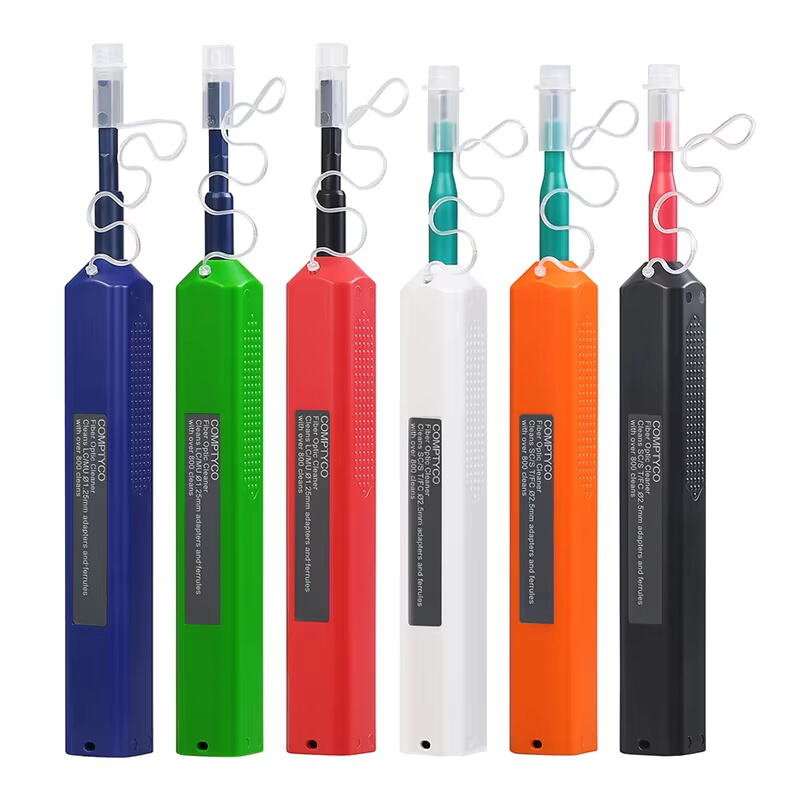फाइबर ऑप्टिक सफाई क्यों महत्वपूर्ण है नेटवर्क प्रदर्शन के लिए
संकेत प्रसारण पर प्रदूषणों का प्रभाव
धूल, तेल और नमी के संदूषण से सिग्नल संचरण की गुणवत्ता बुरी तरह प्रभावित होती है और डेटा खोने का खतरा भी रहता है। शोध से पता चलता है कि केवल एक छोटे से कण के कारण भी सिग्नल की ताकत लगभग आधी रह जा सकती है, जिससे नेटवर्क के समग्र प्रदर्शन में काफी अंतर आता है। जब सिग्नल इस तरह कमजोर होते हैं, तो हमें अधिक देरी (लेटेंसी) और झिंझक (जिटर) की समस्याएं देखने को मिलती हैं। ये समस्याएं ऐसी सेवाओं के लिए मुश्किल पैदा करती हैं, जिनमें तेज और भरोसेमंद डेटा स्थानांतरण की आवश्यकता होती है, जैसे कि वॉइस ओवर आईपी कॉल या ऑनलाइन बैठकें, जहां लोग कैमरों के माध्यम से चेहरा दिखाकर बातचीत करते हैं। फाइबर ऑप्टिक सिस्टम को साफ रखना केवल अच्छी प्रथा नहीं है, बल्कि यह आवश्यक है ताकि कंपनियां अपने संचार को बिना किसी अप्रत्याशित रुकावट के पूरे दिन सुचारु रूप से चला सकें।
फाइबर निर्माण कैसे सफाई की आवश्यकता पर प्रभाव डालता है
फाइबर ऑप्टिक केबल कैसे बनाए जाते हैं, चाहे वे सिंगल मोड हों या मल्टी मोड, इससे उनकी सफाई की आवश्यकता में अंतर पड़ता है क्योंकि विभिन्न कोर आकारों और उनमें प्रकाश के संचरण की विधि में अंतर होता है। उदाहरण के लिए, सिंगल मोड फाइबर लें। इनके कोर काफी छोटे होते हैं, इसलिए धूल के सूक्ष्म कण भी चीजों को बहुत खराब कर सकते हैं। इसका मतलब है कि इन फाइबर्स को ठीक से काम करने के लिए विशेष सफाई तकनीकों की आवश्यकता होती है। वास्तविक फाइबर के चारों ओर की वस्तुएं भी बहुत मायने रखती हैं। विभिन्न सामग्रियों से बने बफर और जैकेट के कारण गंदगी उनसे अलग-अलग तरीके से चिपकती है, जिससे तकनीशियन को यह पता चलता है कि किन सफाई उत्पादों का उपयोग करना है। इसे सही करना केवल चीजों को साफ रखने के बारे में नहीं है, इसका सीधा प्रभाव पूरे संचार प्रणाली के प्रदर्शन पर प्रतिदिन पड़ता है।
फाइबर सफाई पेन का उपयोग करने के बड़े फायदे
अधिकतम प्रकाश प्रसारण के लिए प्रभावी प्रदूषण निकालना
फाइबर सफाई पेन फाइबर ऑप्टिक केबलों पर जमा होने वाली धूल और गंदगी को हटाने में बहुत प्रभावी होते हैं, जिससे नेटवर्क के माध्यम से प्रकाश का संचरण बेहतर होता है। ये छोटे उपकरण अपना काम करने के लिए सिर्फ थोड़ी सी क्लीनिंग सॉल्यूशन की आवश्यकता होती है, जो फाइबर पर जमी हुई लगभग 95-98% गंदगी को हटा देता है। फाइबर को साफ रखना बहुत महत्वपूर्ण है, क्योंकि गंदे कनेक्शन सिग्नल की गुणवत्ता पर काफी बुरा प्रभाव डाल सकते हैं। नेटवर्क तकनीशियनों को इसकी अच्छी तरह से जानकारी होती है, खासकर जब वे उच्च गति वाले इंटरनेट या अन्य डेटा घनत्व वाले कार्यों से निपट रहे होते हैं, जहां थोड़ी सी भी दूषितता भविष्य में बड़ी समस्याओं का कारण बन सकती है।
पारंपरिक साफ़ीकरण विधियों की तुलना में लागत-कुशल विकल्प
फाइबर ऑप्टिक्स के लिए सफाई पेन, पुरानी विधियों जैसे वेट क्लीनिंग या उन लिंट वाइप्स की तुलना में वास्तव में पैसे बचाते हैं जो हर कोई अपने पास रखता है। ये पेन प्रति सफाई सत्र के हिसाब से भी सस्ते होते हैं क्योंकि ये अधिक समय तक चलते हैं और एक बार उपयोग के बाद फेंके जाने वाले उत्पादों के बजाय कई बार दोबारा उपयोग किए जा सकते हैं। समय के साथ, उन कंपनियों के लिए बचत बहुत अधिक हो जाती है जिन्हें अपने फाइबर ऑप्टिक उपकरणों की नियमित रूप से देखभाल करने की आवश्यकता होती है। इसके अलावा, एक बार इस्तेमाल होने वाली सफाई सामग्री से लैंडफिल में कम कचरा जाता है। कंपनियों ने बताया है कि अपने सिस्टम को चिकना चलाने वाले रखने के बावजूद रखरखाव लागतों पर कुल मिलाकर कम खर्च आता है, जिसका मतलब है कि बजट में अन्य महत्वपूर्ण चीजों के लिए अधिक पैसा बचा रहता है।
संकेत खोने और नेटवर्क बंदी को रोकना
विशेष पेन का उपयोग करके फाइबर कनेक्शन की नियमित सफाई मलबे और गंदगी के जमाव से होने वाली सिग्नल समस्याओं को रोकने में मदद करती है, जिससे नेटवर्क सुचारु रूप से काम करते रहते हैं। कंपनियाँ जो अपने नियमित रखरखाव कार्यक्रम में फाइबर सफाई को शामिल करती हैं, अक्सर नेटवर्क आउटेज के मामलों में कम अप्रत्याशित समस्याओं का सामना करती हैं। कुछ व्यवसायों द्वारा यह बताया गया है कि बस फाइबर को साफ रखकर ही प्रतिवर्ष 5,000 से 15,000 डॉलर तक की बचत की जा सकती है, बजाय बाद में महंगी मरम्मत के खर्च के। फाइबर ऑप्टिक्स पर अनुसंधान लगातार साफ-सफाई को विभिन्न प्रकार के नेटवर्क में विश्वसनीय प्रदर्शन का एक प्रमुख कारक बताता है।
क्षेत्रीय तकनीशियनों और इंस्टॉलर्स के लिए पोर्टेबिलिटी
फील्ड टेक्नीशियन और इंस्टॉलर्स को फाइबर सफाई पेन बहुत उपयोगी लगते हैं क्योंकि ये छोटे और हल्के होते हैं जिन्हें पूरे दिन अपने साथ रखा जा सकता है। अधिकांश लोग बस एक पेन को अपने टूलकिट में रेंच और स्क्रूड्राइवर के साथ डाल देते हैं। साइट पर काम करते समय, ये पेन टेक्नीशियन को बल्कि उपकरणों को निकाले बिना जल्दी से कनेक्टर्स की सफाई करने की अनुमति देते हैं। स्थापन के दौरान जब अचानक गंदगी जमा हो जाए या जगह संकरी हो, तो यह तर्कसंगत लगता है। यह बात भी महत्वपूर्ण है कि ये पेन जेब या पॉच में आसानी से फिट हो जाते हैं, इसलिए अब किसी भी काम के बीच सफाई के चरणों को छोड़ने का कोई बहाना नहीं रह जाता। अंततः, किसी को भी गंदे कनेक्शन के कारण बाद में सिग्नल लॉस की समस्या से निपटना नहीं चाहता।
फाइबर ऑप्टिक cleaning पेन का उपयोग करने के लिए चरण-दर-चरण गाइड
प्रारंभिक सफाई जांच की बेहतरीन प्रथाएं
किसी भी सफाई कार्य से पहले सदैव एक माइक्रोस्कोप के अंतर्गत फाइबर ऑप्टिक कनेक्टर के सिरों की जांच करें। धूल के कणों, उंगलियों के निशान या मिट्टी के छोटे-छोटे कणों जैसी चीजों की तलाश करना बहुत महत्वपूर्ण होता है, क्योंकि ये चीजें प्रकाश के फाइबर के माध्यम से सही ढंग से यात्रा करने में बाधा डालती हैं। जब तकनीशियन नियमित रूप से जांच करने की आदत विकसित कर लेते हैं, तो वे समस्याओं का समय रहते पता लगा लेते हैं और यह भी समझ जाते हैं कि किस प्रकार का साफ करने वाला पदार्थ या उपकरण सबसे अच्छा काम करेगा, बिना फाइबर की सतहों को नुकसान पहुंचाए। निरीक्षण के दौरान क्या पाया गया, उसके अभिलेखों को बनाए रखना भी काफी महत्वपूर्ण है। यह सभी को अच्छी रखरखाव आदतों का पालन करने में मदद करता है और भविष्य में समान समस्याएं आने पर उल्लेखनीय संदर्भ सामग्री उपलब्ध कराता है। यदि हम चाहते हैं कि हमारे फाइबर ऑप्टिक नेटवर्क लंबे समय तक रहें और लगातार खराबी न हो, तो उचित अभिलेखन बस स्वाभाविक बात है।
उचित सजायन और क्लिक तकनीक
फाइबर सफाई पेन का उपयोग करते समय संरेखण को सही करना और उचित ढंग से क्लिक कैसे करना है, यह सीखना सब कुछ बदल सकता है। जब फाइबर पेन के सिर के साथ सही ढंग से संरेखित हो जाते हैं, तो गंदगी साफ हो जाती है और नीचे स्थित सूक्ष्म फाइबर संरचना को नुकसान नहीं पहुंचता। इस प्रकार की सफाई करते समय समान दबाव डालकर लगातार क्लिक करने की तकनीक सबसे अच्छा काम करती है। उन तकनीशियनों को जो इन विधियों पर उचित प्रशिक्षण प्राप्त करते हैं, उपकरणों का संचालन बेहतर ढंग से करते हैं, जिसके परिणामस्वरूप सफाई के दौरान कम गलतियां होती हैं। इससे कुल मिलाकर साफ संपर्क बनता है और लंबे समय तक नेटवर्क के प्रदर्शन को बनाए रखने में मदद मिलती है, क्योंकि फाइबर लंबे समय तक अच्छी स्थिति में बने रहते हैं।
सफाई के बाद ऑप्टिकल स्कोप के माध्यम से पुष्टि
सफाई प्रक्रिया पूरी करने के बाद, माइक्रोस्कोप के तहत फाइबर कनेक्शन की जांच करना पूरी तरह से आवश्यक हो जाता है। यह निरीक्षण सफाई के बाद भी वहां मौजूद छोटे कणों को चिह्नित करने में मदद करता है, जो संकेत की गुणवत्ता को प्रभावित कर सकते हैं अगर उन्हें अनदेखा कर दिया जाए। फाइबर ऑप्टिक नेटवर्क के लिए, सफाई के बाद ऐसी जांच केवल अच्छी प्रथा नहीं है, बल्कि गुणवत्ता मानकों और नियामक आवश्यकताओं को पूरा करने के लिए यह मूल रूप से आवश्यक है। जब कंपनियां इन जांचों को अपनी दैनिक दिनचर्या का हिस्सा बनाती हैं, तो उन्हें काफी हद तक विश्वसनीय नेटवर्क संचालन प्राप्त होता है। संचार प्रणालियों के माध्यम से डेटा बिना किसी रुकावट के प्रवाहित होता है क्योंकि संभावित समस्याओं को शुरुआत में ही पकड़ लिया जाता है। केवल अनुपालन के लिए बॉक्स टिक करने के अलावा, ये नियमित जांचें समय के साथ बेहतर रखरखाव की आदतों की ओर ले जाती हैं, जो महीनों या यहां तक कि कई साल बाद नेटवर्क के प्रदर्शन को देखते हुए काफी फायदेमंद साबित होती हैं।
निष्कर्ष: नियमित रखरखाव के साथ फाइबर नेटवर्क को अधिक कुशल बनाना
फाइबर सफाई पेन के लाभों का सारांश
फाइबर सफाई पेन नेटवर्क को चिकनी तरीके से चलाने के लिए बहुत महत्वपूर्ण हैं क्योंकि ये सिग्नल की गुणवत्ता को प्रभावित करने वाली गंदगी और मैल को मिटा देते हैं। ये छोटे से पेन इतने अच्छे क्यों हैं? इनकी कीमत ज्यादा नहीं होती और ये जेब या टूलबॉक्स में आसानी से फिट हो जाते हैं, जिसका मतलब है कि तकनीशियन कहीं भी - चाहे बड़े डेटा सेंटर में हों या किसी पुराने कार्यालय लैन सेटअप की मरम्मत कर रहे हों - फाइबर की सफाई कर सकते हैं। जब कोई व्यक्ति नियमित रूप से कनेक्टर्स की सफाई करता है, तो बैंडविड्थ खोने या अस्थायी कनेक्शन समस्याओं से निपटने की संभावना काफी कम हो जाती है। सभी के लिए रखरखाव आसान बनाने के अलावा, उचित सफाई महंगे उपकरणों को लंबे समय तक काम करने में मदद करती है और भविष्य में अप्रत्याशित खराबी से बचाती है।
प्रायोजनात्मक सफाई के अभ्यास को लागू करना
नियमित फाइबर सफाई कार्यक्रम उन परेशान करने वाले रखरखाव कार्यों को कम करने में वास्तव में मदद करता है जबकि नेटवर्क आउटेज को दूर रखता है। जब कर्मचारी समझते हैं कि साफ फाइबर क्यों महत्वपूर्ण हैं और उनके सफाई उपकरणों को सही तरीके से कैसे संभालना है, तो समय के साथ व्यवसाय सुचारु रूप से चलते हैं और नेटवर्क के समग्र प्रदर्शन में सुधार होता है। सच्चाई यह है कि उचित सफाई के बिना, फाइबर ऑप्टिक सिस्टम उतने लंबे समय तक नहीं चलते या उतने विश्वसनीय नहीं रहते। कंपनियां जो वास्तव में इन सफाई प्रोटोकॉल को अमल में लाती हैं, आमतौर पर लंबे समय तक चलने वाले नेटवर्क भी देखती हैं। और आइए स्वीकार करें, कोई भी किसी अप्रत्याशित समस्या के कारण महंगी आपातकालीन मरम्मत का सामना करना नहीं चाहता। समस्याओं से पहले रखरखाव का ध्यान रखना इस बात की गारंटी देता है कि फाइबर नेटवर्क संचालित रहेंगे, भले ही प्रौद्योगिकी बदलती रहे और विभिन्न उद्योगों में ग्राहकों की अपेक्षाएं बढ़ती रहें।
सामान्य प्रश्न अनुभाग
फाइबर ऑप्टिक में मुख्य प्रदूषक क्या हैं?
फाइबर ऑप्टिक में मुख्य प्रदूषक धूल, तेल और नमी हैं, जो सिग्नल परिवहन पर गंभीर प्रभाव डाल सकते हैं।
'क्लिक तकनीक' क्यों महत्वपूर्ण है?
‘Click तकनीक’ सफाई के दौरान एकसमान दबाव लगाने का योगदान देती है, जिससे फाइबर सफाई पेन की प्रभावशीलता अधिकतम होती है।
फाइबर केबल निर्माण सफाई की आवश्यकताओं पर कैसे प्रभाव डालता है?
फाइबर केबल निर्माण सफाई की आवश्यकताओं को मुख्य रूप से एकल-मोड़ फाइबर में कोर आकारों और प्रकाश पथों के विभिन्नताओं के कारण प्रभावित करता है।
क्या फाइबर सफाई पेन संचालन खर्चों को कम कर सकते हैं?
हाँ, फाइबर सफाई पेन पारंपरिक सफाई विधियों की तुलना में सामग्री का व्यर्थ व्यय और संचालन खर्चों को कम करने वाला लागत-कुशल समाधान है।







